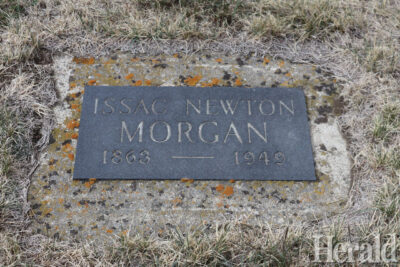Warner family search leads to history of early black settler
By Alejandra Pulido-Guzman - Lethbridge Herald on April 20, 2022.
 Herald photo by Alejandra Pulido-Guzman
The grave marker for black settler Issac Newton Morgan at the Warner Memorial cemetery, which replaced the wooden marker originally installed with (N-word) Morgan written on it.
Herald photo by Alejandra Pulido-Guzman
The grave marker for black settler Issac Newton Morgan at the Warner Memorial cemetery, which replaced the wooden marker originally installed with (N-word) Morgan written on it.LETHBRIDGE HERALDapulido@lethbridgeherald.com
From a road trip through Warner, Alta. in 1996 a seed was planted for an American lawyer to find all he could about a man buried in their local cemetery.
Founder of the Milk River Historical Society, Dale Leffingwell, said he was approached by American lawyer F. Ross Boundy, who was looking for information on a black homesteader who is buried in the Warner Cemetery.
“He was doing family history, because his familyt the Ross family from the Warner area, when he was touring it, he went by a house and it was casually mentioned that’s where this Newton Morgan lived,” said Leffingwell.
He said that when Boundy was advised of the fact that Newton Morgan lived there, the person used the “N-word” prior to saying Newton’s last name.
“He had a fit over that, so then he had to find more about the story, and found out that a relative from the Warner area had decided to replace the grave marker in the cemetery, as she thought it was not appropriate because it was just a wooden marker and had “(N-word) Morgan” written on it,” said Leffingwell.
He said he was able to locate a homestead claim made by Morgan in the 1-17 district west of Milk River, and in the area of the Fort Benton Whoop-Up Trail located a few miles south of the North West Mounted Police Milk River Ridge Detachment through research of old maps of the area.
He said Newton and his wife immigrated from Minneapolis to Canada in 1910 in search of the “Last Best West.”
The “Last Best West” was a phrase used to advertise the Canadian Prairies in Europe and the United States to prospective immigrants from 1896 to 1905.
“Newton tried to develop a horse ranch into a hunting lodge and along with his hunting and taxidermy skills built up a sizeable collection,” said Leffingwell.
He said that in 1921 Morgan traded his homestead with former Milk River Ridge NWMP officer Spud Murphy who always wanted to return to the hills of the Milk River Ridge and therefore traded his Warner homestead with Morgan.
“In true oral history pursuit, our researcher in this story was able to determine that the only black person in town was Newton and was highly thought of. In the Warner history book he was identified as a great hunter, a good sportsman and taught many local boys to shoot,” said Leffingwell.
The researcher he is referring to is the American lawyer who approached him. He said Boundy spoke to multiple Warner residents about Morgan trying to learn all he could about the person his family member replaced the grave marker for.
In a paper he wrote as a result of his research, Boundy mentions that only 12 Internet records have been located from the pallet of Morgan’s life and there is no consensus as to his correct name. His gravestone is the only record of his full name as Issac Newton Morgan. In all other records except one, his name is simply Newton Morgan. In the 1995 U.S. census his name appears as Newton I. Morgan.
“Beyond these spare details, I wanted to learn more about the personality and character of this early Alberta pioneer for whom my mother and her family felt such affection,” said Boundy in his paper.
He was able to contact Phil Dickson, who was 84 at the time and the son of Phyllis Ross Dickson who purchased Morgan’s gravestone. Boundy said in his paper that Dickson speculated that Morgan received some sort of pension because he often saw him riding his horse downtown to pick up his mail.
“The man he only knew as “N-word” Morgan was always friendly and would stop to talk whenever he saw Phil walking to school,” Boundy wrote.
Boundy recalls in his paper talking to Earl Thomas who at the time they spoke was 94 years old and had grown up in Warner, and who remembered with some embarrassment that he could not stop staring at Morgan when he first met him at the age of 13 or 14 because he was the first black person he had ever seen.
“In my hunt for Morgan’s life history, I first worried that the racial attitudes of the day may have also kept him from the close friendships he surely deserved. That concern now seems overblown and inaccurate,” wrote Boundy.
For more information you can contact the Milk River Historical Society’s Dale Leffingwell at dbleffin@shaw.ca
Follow @APulidoHerald on Twitter
4-3




